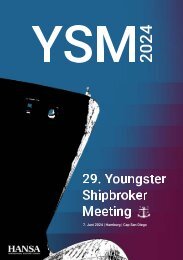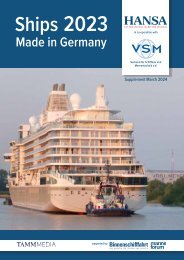HANSA 06-2019
Reparatur & Umbau | Start-Ups | COMPIT Review | CIMAC 2019 | Terminaltechnik | Batterien & Hybrid | Offshore-Flotte | U.A.E. | Cruise Ship Interiors | Zeaborn & Offen
Reparatur & Umbau | Start-Ups | COMPIT Review | CIMAC 2019 | Terminaltechnik | Batterien & Hybrid | Offshore-Flotte | U.A.E. | Cruise Ship Interiors | Zeaborn & Offen
Sie wollen auch ein ePaper? Erhöhen Sie die Reichweite Ihrer Titel.
YUMPU macht aus Druck-PDFs automatisch weboptimierte ePaper, die Google liebt.
Schiffstechnik | Ship Technology<br />
© MAN<br />
Figure 3: A layout A layout diagram diagram that indicates that indicates two SMCR two points. SMCR Moving points. the SMCR Moving closer the to the min. mep line Figure increases A layout diagram indicating two SMCR points. Moving the<br />
4: A layout diagram indicating two SMCR points. Moving the SMCR parallel to lines of constant<br />
engine efficiency; SMCR this closer is called to derating the minimum mep line increases engine efficiency;<br />
increase the SMCR engine parallel efficiency to (but lines may of increase constant propeller mep does efficiency) not increase the engine<br />
this is called derating<br />
efficiency (but may increase propeller efficiency)<br />
Referring to Figure 3, since a given power output from the engine is often required, derating Having is usually discussed how engine efficiency can be improved by careful engine selection<br />
not achieved by reducing the SMCR power but rather by adding an extra cylinder to the relevant engine. With to return to the fuel equation and remember that the approach needs to be ho<br />
an extra cylinder, the layout diagram moves vertically upwards and, for a given position successful: of the SMCR,<br />
this results cal in a energy lower mep by and, the piston thereby, before derating. the combustion<br />
gases are expelled to the exhaust, as high as possible to achieve the high-<br />
the SMCR power RRRR TTTT ∙ VVVVbut rather by adding an<br />
maximum pressure and mep should be rating is usually not achieved by reducing<br />
Figure 4 illustrates compared a movement to the situation of the SMCR in Figure within 1, the resulting<br />
in higher engine efficiency.<br />
ing that a given engine type is designed to layout diagram moves vertically upwards<br />
engine layout est possible diagram engine that will efficiency. not result in Consider-<br />
PPPP ffffffffffffffff extra = cylinder ηηηη to the engine. Thus, the<br />
HHHH ∙ ηηηη OOOO ∙ ηηηη RRRR ∙ ηηηη SSSS ∙ ηηηη<br />
derating.<br />
EEEE<br />
Advances in engine design have made withstand a certain maximum pressure, and, for a given position of the SMCR,<br />
it possible to design marine two-stroke<br />
engines that are capable of withstanding<br />
the objective is to reduce From mep the fuel if the equation, focus it is clear this that results although in a lower have mep now and, spent thereby, some time poring o<br />
is more on high engine efficiency, η E , than the engine on efficiency derating. is just Figure one element 4 illustrates of vessel a movement fuel-efficiency. Chang<br />
maximum cylinder pressures of 200bar. high engine power. efficiency may have implications of the on the SMCR other within elements the of engine the fuel layout equation, di-foagram examp<br />
larger engine that will to develop not result a given in derating. power in order to achie<br />
This makes it possible to reach unprecedented<br />
engine efficiencies and lower engine, the degree of derating may can result be seen in a change of Having the aft-ship discussed hull lines how that engine may affect efficien-<br />
R T , η H , η O and<br />
When ordering a marine • Selecting two-stroke a physically<br />
SFOC. By derating it is possible to achieve by the position of the specified negative maximum way, cy can be improved by careful engine<br />
even lower fuel consumption.<br />
continuous rating (SMCR) • Moving the engine the SMCR within selection the engine and layout, diagram, let’s return to achieve to derating, the in a w<br />
layout diagram (Figures 3 and a change 4). Referring<br />
of the propeller fuel curve equation may influence and remember η O and ηthat R in a the way ap-<br />
that may can<br />
to Figure 3, since a given effect power of the out-<br />
derating. proach needs to be holistic to be success-<br />
More on derating<br />
put from the engine is often required, deful.<br />
From the fuel equation it is clear that<br />
These interactions complicate the vessel-design process and it is important to get them<br />
The degree of derating can be identified<br />
by how much the maximum engine<br />
However, this is also what makes vessel the fuel-efficiency. life of the naval architect Changing interesting, engine so letʼs not<br />
to build a vessel with the lowest engine possible efficiency fuel consumption η E is just and one the element smallest of possible c<br />
torque is reduced. Although it is possible<br />
difficulties but focus on the possibilities. efficiency may have implications on the<br />
to look at the torque values, it is more<br />
usual and typically easier to look at the<br />
so-called »mep« values that are independent<br />
of engine size (mep = mean effective<br />
pressure, work done per engine<br />
cycle per cubic meter of engine displacement<br />
V d). Engine designers use mep instead<br />
of torque almost exclusively.<br />
mep = W cycle : V d , mep is proportional to<br />
engine torque according to:<br />
mep = 2 ∙ π ∙ Torque ∙ x :V d (x = 1 for a<br />
2-stroke engine, x = 2 for a 4-stroke engine,<br />
all values in SI units)<br />
Derating an engine reduces maximum<br />
torque – equivalent to maximum mep –<br />
in order to create an engine with a lower<br />
fuel consumption. A high maximum<br />
other elements of the equation, e.g.:<br />
••<br />
Selecting a physically larger engine to<br />
develop a given power in order to<br />
achieve derating may result in a change<br />
of the aft-ship hull lines that may negatively<br />
affect R T, η H, η O and η R.<br />
••<br />
Moving the SMCR within the engine<br />
layout diagram, to achieve derating, in<br />
a way that forces a change of the propeller<br />
curve may influence η O and η R in<br />
a way that may cancel the positive derating<br />
effect.<br />
These interactions complicate the vessel-design<br />
process. It is important to get<br />
them right in order to build a vessel with<br />
the lowest possible fuel consumption and<br />
the smallest possible carbon footprint.<br />
cylinder-pressure also reduces fuel consumption.<br />
Combining the two concepts<br />
leads to the old rule that the ratio between<br />
Author: Kim Rene Hansen, Senior Research<br />
Engineer, MAN Energy Solutions<br />
© MAN<br />
58 <strong>HANSA</strong> International Maritime Journal <strong>06</strong> | <strong>2019</strong>


















